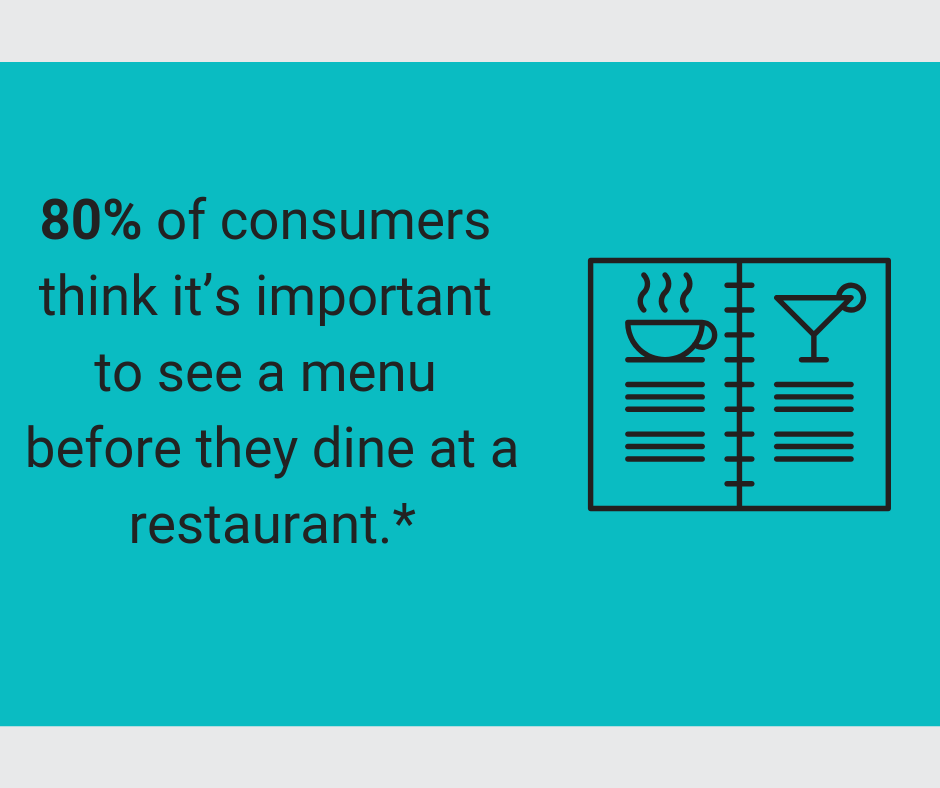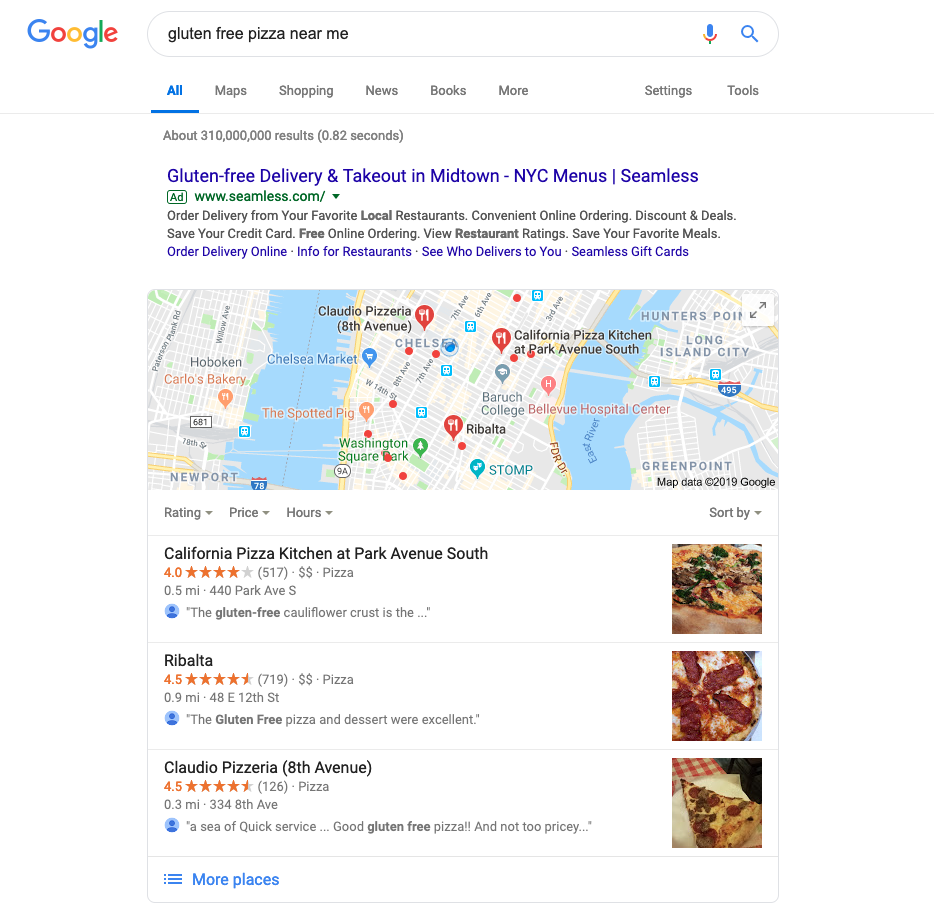Restaurant Menus: The Secret to More Customers
Molly Weinberg
5 min read
Feb 25, 2019

Molly Weinberg
5 min read
Feb 25, 2019

Stop losing customers because you haven’t updated your restaurant menu online. Search engines, review sites and voice assistants have changed how people search for a restaurant. It used to be that when people opened up a browser or pulled out their phone to search for a restaurant, they got a bunch of links in a search engine that led them straight to the website. If you wanted your restaurant to be at the top of that list, you had to optimize your website for SEO.But it’s not that simple anymore.SEO optimization for your website is still very important, but now you also have to manage your restaurant menu and public information on the sites that people use before they end up on your website. Publishers like Google My Business, Yelp, TripAdvisor, and Facebook are trying to give searchers all the information they need through business listings for each company. These sites often get the first click when a hungry customer is searching for your restaurant. The idea is that the person searching gets all the information they need right away, without having to click off to the restaurant’s website, until they need more details or need to do something like make a reservation.
Learn More: Local Search: 5 Ways to Boost Your Restaurant’s SEO & Online Visibility
What makes it more complicated for a restaurant owner is that very often, new guests aren’t searching for your, or any, restaurant by name. Instead, people are searching for what they crave. Said another way, people go to Google, Bing, Foursquare and Yahoo to search “pizza near me,” “best lunch downtown,” or a query like “kid friendly restaurant with hot dogs,” more often than they search for a specific restaurant. In fact, according to a study by TouchBistro, 63% of restaurant goers say that the type of food would have the biggest impact on their restaurant choice. These searches are known as “unbranded search” and typically return results that display the business listings first, before links to a restaurant’s website.
Your menu — and all the places it lives online — is one of the best tools you have to help you get more online visibility in unbranded searches. That includes your website, as well as the dozens of other places it can be found online, including listing sites like Zomato, Zagat, Menupages and Mapquest. There are several reasons why these listings should be important to you and your business. When it comes to online discovery for restaurants, search engines like Google, Yahoo! And Bing index search results based on a system of relevance. Meaning, they are trying to give people the best answer. The search engines want to make sure the information is correct and to do that, they need to know its accurate. Restaurant owners, who claim their businesses with these publishers, verify their details by updating it with their correct information, and this sends a signal that this is an active business.
When it comes to online discovery for restaurants, search engines like Google, Yahoo! And Bing index search results based on a system of relevance. Meaning, they are trying to give people the best answer. The search engines want to make sure the information is correct and to do that, they need to know its accurate. Restaurant owners, who claim their businesses with these publishers, verify their details by updating it with their correct information, and this sends a signal that this is an active business.
The more publishers that you can do this with, the stronger the signal you send that you can guarantee the public information about your business is correct.One of the ranking factors that Google considers when giving answers can be influenced by accuracy across the web. The more search engines, review sites and navigation apps with the same information, the stronger signal of accuracy it sends to the search engines and publishers. When that answer confirms in search that your restaurant menu has what a customer craves, like waffle fries, a spring salad or bang bang shrimp, you are more likely to come up as a relevant answer for that search. If you are only managing your restaurant menu on your website, you make it harder for Google, Facebook, Yelp and other publishers to know if your business is the right answer for that search.Many restaurants feel overwhelmed by menu management because it’s a lot of information to keep updated, especially when there are menus in multiple places.
A lot of restaurants try to save time by creating a PDF file that they can print in the restaurant, print to hand out and upload to their website so that people can download it. While that can save some time, it can also really hurt your business online.The major search engines speak their own language called “schema.” This language helps the search engines understand information about the business so that they can index it for search results. A website with proper schema markup tells the web crawlers searching for information that you are indeed a restaurant with specific operation hours, a phone number and an address. It can also tell them what is on a restaurant’s menu. The search engines take this information and use it to optimize your search results.When you use a PDF to publish your restaurant menu on your website, you are making it difficult for the search engines to read it. There is no schema markup on a PDF, or even html, it’s just text on a printable document. So they may not find the information they need to be able to know what you serve on your restaurant menu. Don’t let laziness cost you business, stop using PDFs to publish your menu online.These 3rd party sites have their own audiences that use them to discover local restaurants and make decisions about dining there. It’s important that when customers are on those sites, and they want to see the dishes on your restaurant menu that you have control of it and it’s accurate. That way when they are ready to make a decision, they have the restaurant menu information they need to confirm their choice. When a customer can see that you do indeed serve a gluten-free pizza, have chicken nuggets on your kids menu, or have a frittata with goat cheese and micro-greens available at brunch, they can then click to call you, request directions or make an online reservation directly with you to come and dine. Controlling your restaurant menu online ensures that you can capture hungry customers at the right point in their decision making journey.The problem is that there are dozens and dozens of places your restaurant menu lives online. Knowing about all of those sites, let alone which are the most important, on its own, is a huge task. Let’s say you were able to create a list of all the publishers where customers and search engines get information about your restaurant menu, you would then have to verify and claim your business listing on each and every one.
When a customer can see that you do indeed serve a gluten-free pizza, have chicken nuggets on your kids menu, or have a frittata with goat cheese and micro-greens available at brunch, they can then click to call you, request directions or make an online reservation directly with you to come and dine. Controlling your restaurant menu online ensures that you can capture hungry customers at the right point in their decision making journey.The problem is that there are dozens and dozens of places your restaurant menu lives online. Knowing about all of those sites, let alone which are the most important, on its own, is a huge task. Let’s say you were able to create a list of all the publishers where customers and search engines get information about your restaurant menu, you would then have to verify and claim your business listing on each and every one.
A big problem is that many of them don’t allow restaurant owners to take control of their own listings. Even if you could, you would then have to update every single menu item, line by line, to make sure they are accurate. If you add or delete something, you would then have to go back and make those amendments, everywhere online.It’s for sure a daunting task but there are a number of business listing software solutions, such as SinglePlatform, Yext, Synup, Momentfeed, and Moz, available that would allow you to manage that process all inside one dashboard. When evaluating them, there are a couple of things to consider:Publishers – which sites do they help you manage your menu on? Having as many as possible would be best.
You’ll need to claim, verify and update your information on each. You’ll also want to set a reminder to go back and check accuracy. Information on those sites can often change and update without you even receiving a notification. Over time the information about your restaurant menu can change. I’d suggest you check once a month to make sure your restaurant’s menu is correct. Set a reminder for yourself on a monthly basis to go through all of your online restaurant menu listings. I guarantee that after only one round of updates, you’re going to wish you had software that could save you that time. Having the right software will not only optimize your restaurant for search, it will save you hours and hours of time from updating your restaurant menus online, but it will also help you get in front of the customers who are craving what you have to offer, but just don’t know it yet.